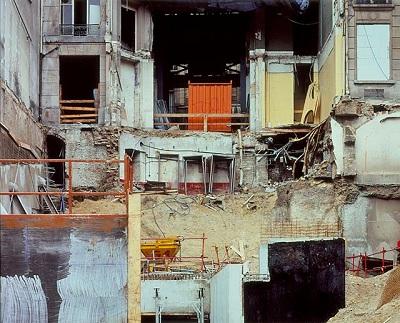Can omitting the context of location from a photograph of architecture remove its identity? Is a building defined by its country of origin? Is a photograph? These are some of the questions that come to mind when looking at the works in the exhibition Construction/Deconstruction: Defining Architectural Photography.
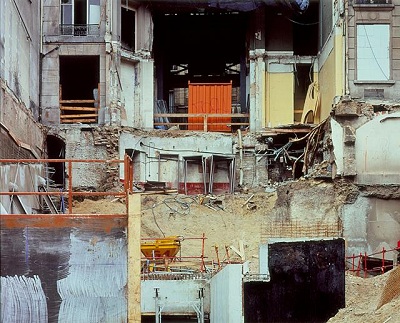 Stéphane Couturier, Rue Chateaudun, Paris, 1996, Ralph M. Parsons Fund, © S. Couturier
Stéphane Couturier, Rue Chateaudun, Paris, 1996, Ralph M. Parsons Fund, © S. Couturier
Stéphane Couturier’s photograph of a building site (or is it a demolition zone?) embraces the historical layers that are part of the DNA of a city such as Paris. It’s intriguing because the subtle hues of the image seem to embody the tonal light that is characteristic of the City of Light. What if the identifying title, Rue Chateadun, Paris, was stripped from this image? Would the light read as Parisian? Would this photograph have less of an impact? In many ways, gallery spaces can be seen as abstracted forms of architecture. The galleries at LACMA, for instance, are constantly in flux with the mounting of each exhibition. The gallery spaces that were created specifically for the exhibition Stanley Kubrick will soon be home to Under the Mexican Sky: Gabriel Figueroa—Art and Film.Where there is now open space will soon be outfitted with walls and structure, in which both still and moving images will be placed.
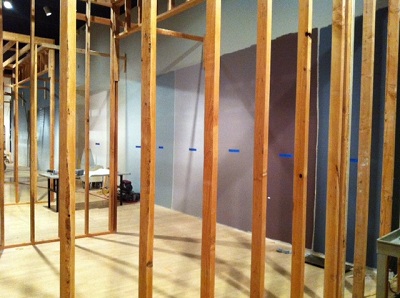 A gallery at LACMA during construction. Like Couturier's photograph, the context is removed, and the viewer is left to absorb the vocabulary of the forms within to place the space.
A gallery at LACMA during construction. Like Couturier's photograph, the context is removed, and the viewer is left to absorb the vocabulary of the forms within to place the space.
In an image (below) from the 1960s, Manuel Carrillo depicts stonework found in Mexico. It hints of an ancient structure, but is it? By focusing on a detail of a larger structure, Carrillo strips the building down to parts. We can, however, still read the building blocks, the strong light creating deep shadows, and the malevolent bird perching (perhaps a nod Mexican symbolism?).
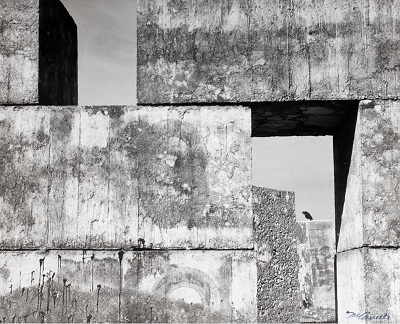 Manuel Carrillo, Untitled (5022), c. 1960, the Marjorie and Leonard Vernon Collection, gift of the Annenberg Foundation, acquired from Carol Vernon and Robert Turbin
Manuel Carrillo, Untitled (5022), c. 1960, the Marjorie and Leonard Vernon Collection, gift of the Annenberg Foundation, acquired from Carol Vernon and Robert Turbin
Below, this “pop-up” gallery at LACMA—shown before emerging from construction—now houses 17th-century European metals, bronzes, and terracotta. Almost overnight, it transformed from anonymous space to a named gallery.
 A LACMA gallery in transition.
A LACMA gallery in transition.
The work of Richard Barnes also comes to mind, specifically a suite of images depicting the crime scene that was the Unabomber’s cabin, a site that changed our definition of the term “cabin” forever. Questions arise with such a consideration: which came first, the location/context or composition/concept?
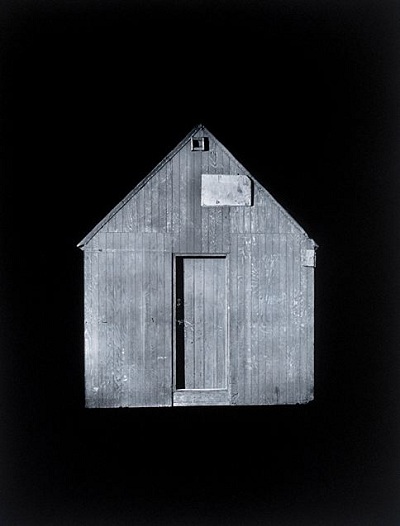 Richard Barnes, Unabomber Cabin Exhibit B, 1998, Ralph M. Parsons Fund, © Richard Barnes
Richard Barnes, Unabomber Cabin Exhibit B, 1998, Ralph M. Parsons Fund, © Richard Barnes
Similarly, Simon Norfolk’s work reference paintings made during the height of the British Empire, in the 19th century. These vast paintings enabled the citizens of the Empire to bring into their homes images of the lands they colonized. Norfolk’s contemporary depiction of the Gates of Baghdad subtly skews this history, as the same edifices that were once celebrated as stakes to a colonial land are depicted in stages of destruction.
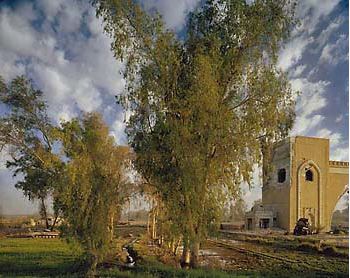 Simon Norfollk, The North Gate of Baghdad, 2003, Ralph M. Parsons Fund, © Simon Norfolk
Simon Norfollk, The North Gate of Baghdad, 2003, Ralph M. Parsons Fund, © Simon Norfolk
James Welling’s work from 2003 seems to hint at an future-past L.A., in twilight and not quite in ruins, but a dim glow of its former self. But what would we infer if it wasn’t labeled West Los Angeles?
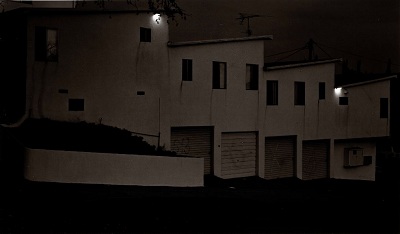 James Welling, West Los Angeles Apartments, 2003, gift of the artist, © James Welling
James Welling, West Los Angeles Apartments, 2003, gift of the artist, © James Welling
Even after the many exhibitions throughout L.A. this summer as part of the Pacific Standard Time Presents initiative, the topic of Los Angeles and architecture, and specifically the subgenre of "architectural photography" remains elusive. Come see this exhibition—and the other PSTP shows—before they close to be part of the discussion. Eve Schillo Curatorial Assistant, Wallis Annenberg Photography Department



